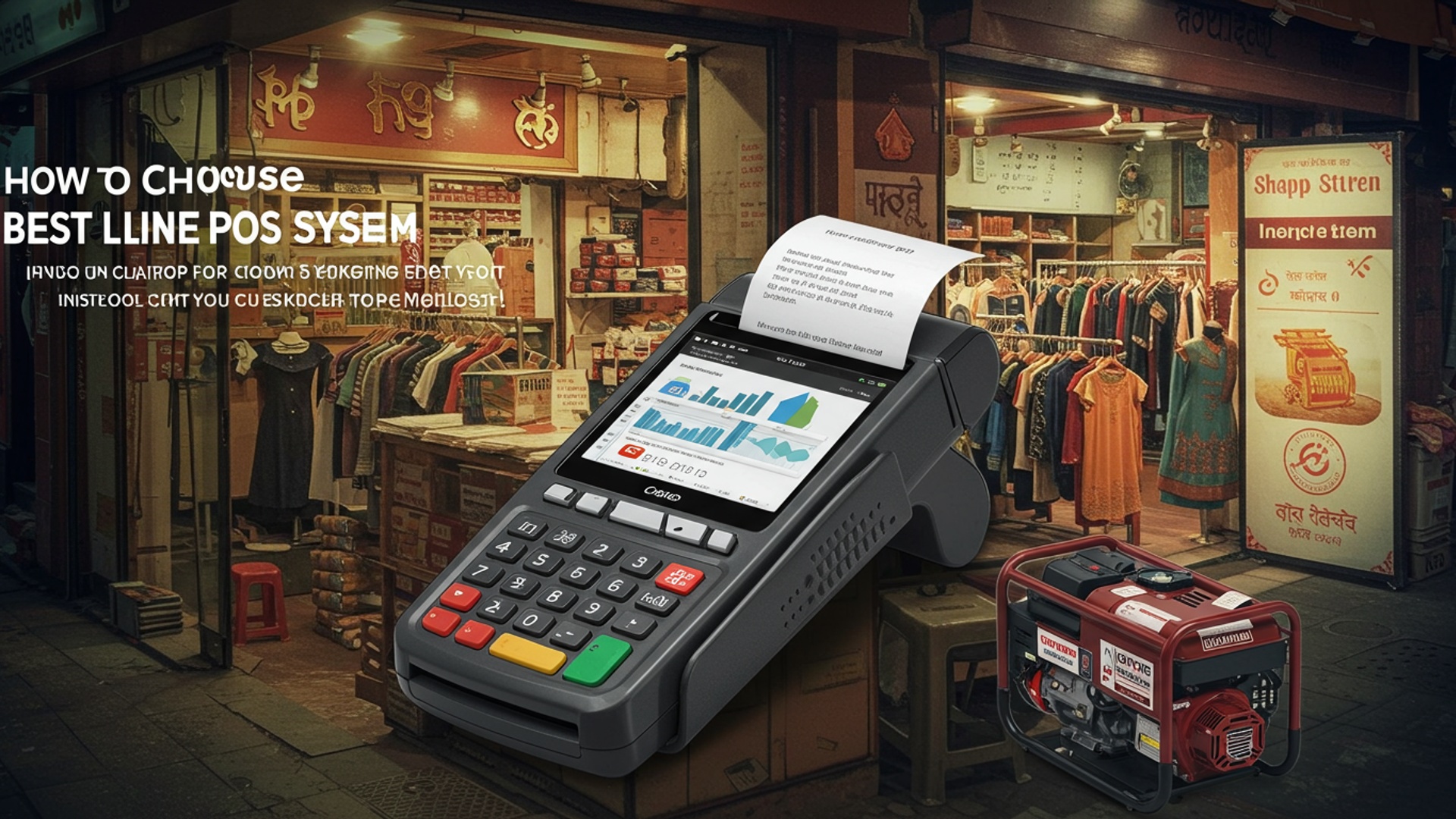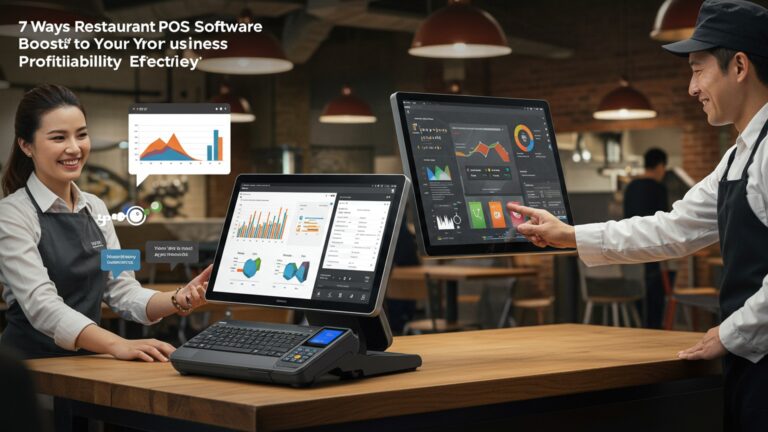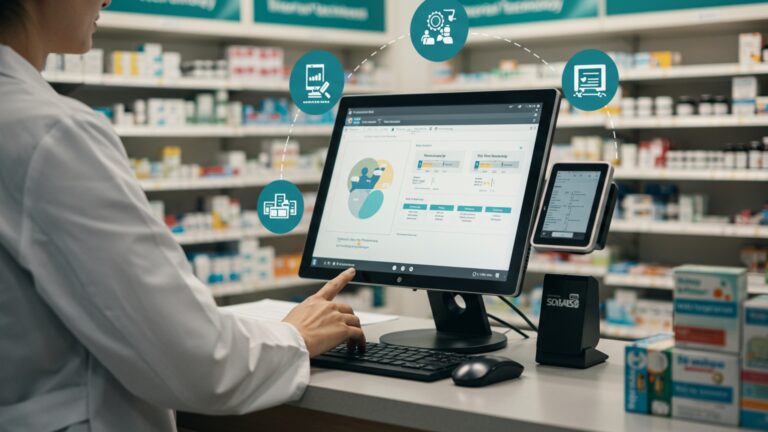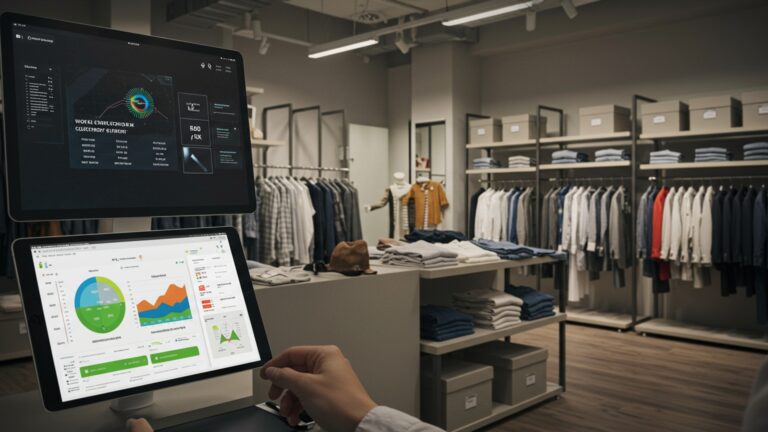How to Choose the Best Offline POS System for Your Indian Clothing Store
Navigating India’s bustling retail environment, particularly for clothing stores, demands a Point of Sale (POS) system that guarantees uninterrupted operations regardless of connectivity challenges. While cloud-based solutions offer numerous benefits, the prevalent infrastructure realities—like intermittent internet and power fluctuations in many Indian cities—underscore why a robust clothing POS offline mode India is not just a fallback. a strategic imperative. Modern offline POS systems now feature advanced local data storage and intelligent synchronization capabilities, ensuring sales transactions, inventory updates for diverse apparel. customer data are meticulously captured and reconciled even during complete network outages. This critical functionality prevents revenue loss, maintains precise stock management. preserves the crucial in-store customer experience, directly impacting your store’s profitability and reputation.

Understanding the Core: What is an Offline POS System?
In the dynamic world of retail, a Point of Sale (POS) system is the central nervous system of any business operation. It’s not just a cash register; it’s a comprehensive solution for managing sales, inventory, customers. more. While many modern POS systems are cloud-based, requiring a constant internet connection, an offline POS system operates independently of the internet for core transaction processing. This means that even if your store’s internet connection drops, you can continue to ring up sales, process payments (for certain types). manage essential inventory tasks without interruption.
The distinction between online, hybrid. offline POS systems is crucial, especially for businesses in regions like India where internet connectivity can be inconsistent.
- Online (Cloud-based) POS
- Offline POS
- Hybrid POS
Relies entirely on an internet connection to function. Data is stored and accessed in the cloud.
Stores data locally on the device (terminal, computer) and operates fully even without internet. Data is typically synced to a central server or cloud when connectivity is restored.
Offers the best of both worlds, usually a cloud-based system with robust offline capabilities. It functions seamlessly offline and syncs data once online, combining flexibility with reliability. This is often the ideal solution. when we discuss “offline POS,” we generally refer to systems with strong hybrid capabilities.
For an Indian clothing store, the ability to operate in an offline mode is not merely a convenience; it’s a strategic necessity to ensure business continuity and customer satisfaction.
Why Offline Mode Matters for Your Indian Clothing Store
For clothing retailers in India, embracing a POS system with robust offline capabilities can be a game-changer. The unique operational environment, coupled with the nature of apparel sales, makes clothing pos offline mode india a critical consideration. Here’s why it’s indispensable:
- Uninterrupted Sales & Revenue
- Reliability in Diverse Locations
- Enhanced Speed & Efficiency
- Data Security & Local Control
- Cost-Effectiveness
- Specifics for Apparel Retail
Imagine a busy festival season or a weekend rush. your internet connection suddenly fails. With an offline POS, sales continue seamlessly. Your staff can process transactions, print receipts. manage inventory without losing a beat, preventing lost sales and frustrated customers.
India’s internet infrastructure, while rapidly improving, can still be patchy, especially in smaller towns, bustling market areas, or even specific spots within large malls. An offline system guarantees operational stability regardless of network availability.
Local processing of transactions can often be faster than relying on constant cloud communication, leading to quicker checkout times, especially during peak hours. This significantly improves the customer experience in a fast-paced retail environment.
While cloud systems offer their own security, local data storage in offline mode provides an immediate layer of control. Sensitive sales and customer data are retained on-site until a secure sync can be performed, reducing immediate vulnerability to external network threats.
Reduced reliance on constant high-bandwidth internet can translate into lower operational costs for some businesses, although hybrid systems still leverage cloud for long-term storage and advanced features.
Clothing stores often deal with high transaction volumes, intricate inventory (SKUs based on size, color, style). frequent returns/exchanges. An offline system ensures these complex operations remain smooth even when connectivity is absent, maintaining accurate stock counts and customer records.
Key Features to Look for in an Offline POS System for Apparel Retail
Choosing the right offline POS means identifying features that directly address the unique needs of a clothing store. Here are the essential functionalities:
- Advanced Inventory Management
- SKU Management
- Batch & Lot Tracking
- Variant Management
- Stock Level Alerts
- Multi-Location Inventory
- Barcode Generation & Scanning
- Customer Relationship Management (CRM)
- Customer Profiles
- Loyalty Programs
- Offline Data Capture
- Sales Reporting & Analytics
- Offline Data Collection
- Post-Sync Reporting
- Customizable Reports
- Employee Management
- User Permissions
- Shift Management
- Commission Tracking
- Flexible Payment Processing
- Cash Transactions
- UPI Integration
- Card Payments
- Gift Cards & Store Credit
- Returns & Exchanges
- Seamless Processing
- Restock Management
- Promotions & Discounts
- Flexible Discounting
- Coupon Management
This is paramount for apparel. Look for robust features like:
Ability to create and track SKUs by size, color, style, fabric. season.
For specific collections or imported goods.
Easily manage multiple variations of a single product.
Automatic notifications for low stock.
If you have more than one store, even if primarily offline, eventual data synchronization is key for a consolidated view.
Essential for quick checkouts and accurate stocktakes.
Build loyalty and personalize experiences.
Store purchase history, contact details, preferences. birthdays.
Manage points, discounts, or special offers for repeat customers.
Collect customer data even without internet, syncing later.
Gain insights to make informed decisions.
All sales data captured locally.
Generate detailed reports on sales trends, best-selling items, employee performance. peak hours once data is synced to the cloud.
Tailor reports to focus on apparel-specific metrics like color popularity or size demand.
Streamline staff operations and monitor performance.
Assign different access levels (e. g. , cashier, manager).
Track clock-ins/outs and sales performance per employee.
If applicable for sales staff.
Crucial for the diverse payment landscape in India.
Core functionality.
Direct support or seamless integration with UPI apps/QR codes.
Compatibility with offline card terminals (which can store transactions and batch-process when online) or integrated payment gateways that support offline mode.
Manage these even without internet.
A common occurrence in clothing retail.
Quick and accurate returns, exchanges. refunds.
Automatically update inventory upon return.
Implement sales strategies effectively.
Apply percentage, fixed amount, or BOGO offers.
Track and redeem coupons.
Hardware Essentials: Building Your Robust Offline Setup
The best offline POS software is only as good as the hardware it runs on. For an Indian clothing store, a reliable and durable hardware setup is key. Here are the components you’ll need:
- POS Terminal
- Dedicated POS Machine
- Tablet-based POS
- Desktop PC/Laptop
- Barcode Scanner
- 1D Scanner
- 2D Scanner
- Wireless vs. Wired
- Receipt Printer
- Thermal Printer
- Impact Printer
- Connectivity
- Cash Drawer
- Often integrates with the receipt printer to open automatically.
- Card Reader/Payment Terminal
- Look for terminals that support “store and forward” or offline transaction mode, allowing card transactions to be captured and then processed in a batch when internet connectivity is restored. This is crucial for a clothing pos offline mode india setup.
- Ensure compatibility with leading Indian payment processors.
- Power Backup (UPS – Uninterruptible Power Supply)
- A UPS provides temporary power during outages, giving you time to complete transactions, save data. safely shut down your system without data loss or hardware damage.
This is the brain of your operation.
Robust, all-in-one units designed for retail environments.
Often more affordable and portable (e. g. , an Android or iPad tablet with a stand). ensure it has sufficient local storage and processing power for offline operations.
Can be used with POS software, offering flexibility but less streamlined than dedicated units.
Speeds up checkout and inventory management.
For traditional linear barcodes.
Can read QR codes and other matrix codes, often more versatile for future needs.
Wireless offers greater mobility, useful for stocktaking.
Essential for proof of purchase.
Fast, quiet. uses heat to print, requiring no ink cartridges. Most common for POS.
Uses an ink ribbon, useful for printing multi-part forms but slower and noisier. Less common for modern retail.
USB, Ethernet, or Bluetooth.
Secure storage for cash transactions.
For processing debit/credit cards.
Absolutely vital in India.
Software Deep Dive: Navigating the Offline POS Landscape
While hardware provides the foundation, the software is where the magic happens. A robust offline POS software solution for your Indian clothing store needs to excel in several key areas:
- User Interface (UI) and User Experience (UX)
- Intuitive Design
- Touch-Friendly
- Customizable Layouts
- Local Database Management
- Robust Local Storage
- Data Integrity
- Example of local data storage
- Seamless Data Synchronization
- This is the bridge between offline and online. When internet connectivity is restored, the system should automatically and securely sync all collected offline data (sales, returns, inventory updates, new customer sign-ups) to the central cloud server.
- Conflict Resolution
- Bandwidth Efficiency
The interface should be easy to comprehend and navigate, minimizing training time for staff.
Most modern POS systems are touch-based, ensuring quick and accurate inputs.
Ability to arrange frequently used buttons or product categories for faster service.
The software must efficiently store all transaction, inventory. customer data locally on the POS terminal. This local database is what allows it to function entirely offline.
Mechanisms to ensure data consistency and prevent corruption during power outages or unexpected shutdowns.
Many offline POS systems use embedded databases like SQLite or proprietary file-based databases to store transaction logs and inventory updates directly on the device.
The system should have intelligent mechanisms to resolve data conflicts if, for example, an item’s stock was updated both offline and online simultaneously (though less likely in a single-store offline setup).
Efficient synchronization protocols minimize the amount of data transferred, making the most of potentially slow internet connections.
// Example of a hypothetical data synchronization trigger // This would typically be an automated background process function initiateOfflineDataSync() { if (networkStatus. isOnline()) { console. log("Network online. Initiating data sync...") ; uploadLocalTransactionsToCloud(); downloadCloudInventoryUpdates(); updateLocalDatabase(); console. log("Data sync complete.") ; } else { console. log("Network offline. Sync postponed.") ; } } // This function would be called periodically or upon network status change
- Local Data Encryption
- User Access Controls
- Audit Trails
Protects sensitive local data from unauthorized access.
Granular permissions to restrict what staff can do.
Log all actions performed on the POS, helpful for accountability and troubleshooting.
- Tailored for Clothing
- Multi-Store Support
- Integration Capabilities
Can it be customized to add specific product attributes (e. g. , fabric type, designer)?
Even if starting with one store, consider if the system can scale to multiple locations with centralized management once online.
Can it integrate with accounting software, e-commerce platforms, or other business tools?
- Most POS software runs on Windows, Android, or iOS. Choose one that aligns with your hardware preference and staff familiarity.
Comparing Offline POS Solutions: A Feature Checklist
When evaluating different offline POS solutions available in the Indian market, it’s helpful to have a comparative framework. Here’s a table outlining key features to consider:
| Feature Category | Consideration Points | Low-Cost Option | Mid-Range Option | Premium Option |
|---|---|---|---|---|
| Offline Capability | How complete is offline functionality? (Transactions, inventory, returns) | Basic sales & limited inventory | Full sales, inventory, CRM (offline) | Full suite, seamless offline-online transition |
| Inventory Management | SKU variants, multi-store, stock alerts, barcode generation | Basic SKU, no variants | Good SKU, variants, alerts | Advanced multi-location, batch, analytics |
| CRM & Loyalty | Customer profiles, purchase history, loyalty programs | Basic customer data | Profiles, history, simple loyalty | Advanced CRM, personalized marketing, robust loyalty |
| Reporting & Analytics | Offline data capture, post-sync reports, custom reports | Basic sales reports (post-sync) | Standard sales, inventory, employee reports | Detailed analytics, custom dashboards, AI insights |
| Payment Processing | Cash, UPI, integrated card processing (offline mode) | Cash, UPI (manual entry) | Cash, UPI, integrated offline card processing | All payment types, advanced offline card batching |
| Hardware Compatibility | Supported terminals, scanners, printers, card readers | Limited hardware options | Flexible with common hardware | Broad compatibility, certified hardware |
| Data Synchronization | Automatic vs. manual, conflict resolution, speed | Manual sync required | Automatic sync, basic conflict resolution | Real-time background sync, advanced conflict resolution |
| Pricing Model | One-time purchase, monthly subscription, per-terminal fee | Low one-time or basic monthly | Moderate monthly, feature-based tiers | Higher subscription, comprehensive support |
| Customer Support | Availability, channels (phone, email, chat), local support | Email only, limited hours | Email, chat, phone (business hours) | 24/7 multi-channel, dedicated account manager |
Implementation and Training: Making the Transition Smooth
Even the best offline POS system can fail if not implemented correctly and if staff aren’t adequately trained. A smooth transition is crucial for business continuity.
- Data Migration
- Existing Inventory
- Customer Database
- Historical Sales Data
- Staff Training
- Hands-on Sessions
- Offline Mode Drills
- Reference Materials
- System Testing
- Pre-Launch Trials
- Stress Testing
- Hardware Checks
- Backup Procedures
- Establish clear protocols for backing up local data. Even with automatic cloud sync, local backups provide an extra layer of security.
- grasp how to restore data in case of hardware failure.
Transfer your current stock data (product names, SKUs, quantities, prices) into the new system. This might involve importing CSV files or manual entry. Accurate data migration is critical for avoiding discrepancies.
Import existing customer details and loyalty program data.
If possible, migrate historical sales data for continuity in reporting, though this is often less critical for a new system.
Conduct practical training sessions with all staff members who will be using the POS. Focus on common tasks like ringing up sales, processing returns, applying discounts. managing cash.
Crucially, train staff on how the system behaves in offline mode. What happens when the internet goes out? How do they complete a sale? How does the data sync later? This builds confidence in a clothing pos offline mode india environment.
Provide quick reference guides or cheat sheets for common procedures and troubleshooting steps.
Before going live, run several trial transactions, including sales, returns. inventory adjustments, both with and without internet connectivity.
Simulate peak sales periods to ensure the system can handle high transaction volumes without lag or errors.
Verify that all peripherals (scanners, printers, card readers) are correctly configured and communicating with the POS software.
Real-World Scenario: An Indian Clothing Boutique’s Offline POS Journey
Consider “Threads & Hues,” a popular ethnic wear boutique in a bustling market in Jaipur. Their previous manual billing system was slow, prone to errors. offered no insights into inventory or customer preferences. They decided to upgrade. with frequent internet fluctuations in their area, a purely online POS was a non-starter. They needed robust clothing pos offline mode india capabilities.
Threads & Hues opted for a hybrid offline POS system that came with a dedicated POS terminal, a thermal printer. a 2D barcode scanner. Here’s how it transformed their operations:
- Seamless Festival Season
- Accurate Inventory
- Personalized Customer Service
- Reduced Errors and Better Reporting
During Diwali, when their store sees its highest footfall and local internet often struggles, the offline POS proved invaluable. Sales continued without a hitch, with every transaction recorded locally. Customers experienced faster checkouts, leading to higher satisfaction and throughput.
The system allowed them to track every saree, lehenga. kurta by size, color. fabric. When a customer asked for a specific size, staff could instantly check availability without relying on the internet. Inventory updates from sales were recorded offline and synced overnight, giving the owner accurate stock levels every morning.
Even offline, they could quickly access a customer’s purchase history (if previously synced) or create new customer profiles. This allowed them to offer personalized recommendations and track loyalty points, which synced to the cloud later for consolidated management.
Manual errors in billing and stock management were virtually eliminated. Post-sync, the owner could generate detailed reports on best-selling garments, peak sales times. employee performance, helping them make data-driven decisions for their next collection and staffing.
This move allowed Threads & Hues to maintain operational excellence, enhance customer experience. gain critical business insights, all while navigating the practical challenges of internet connectivity in their location.
Budgeting for Your Offline POS System: What to Expect
Investing in an offline POS system for your Indian clothing store requires careful financial planning. The costs can vary significantly based on the system’s sophistication, features. vendor. Here’s a breakdown of what to consider:
- Software Costs
- Subscription Model (Most Common)
- One-Time License (Less Common for Offline/Hybrid)
- Hardware Costs
- POS Terminal
- Barcode Scanner
- Receipt Printer
- Cash Drawer
- Card Reader/Payment Terminal
- UPS (Uninterruptible Power Supply)
- Installation and Training Costs
- Some vendors include basic setup and remote training in their package. Others might charge an additional fee for on-site installation, data migration. comprehensive staff training. This can range from ₹5,000 to ₹25,000 or more.
- Ongoing Support & Maintenance
- Beyond the initial setup, consider the cost of ongoing technical support, software updates. any hardware maintenance contracts. This is often bundled into subscription plans but can be a separate annual fee for perpetual licenses.
- Hidden Costs
- Consumables
- Internet Connection
- Payment Gateway Fees
Many hybrid offline POS systems operate on a monthly or annual subscription fee. This typically includes software updates, cloud synchronization. basic support. Prices can range from a few hundred rupees to several thousands per month, depending on the features and number of terminals.
Some purely offline systems might offer a perpetual license for the software. While the upfront cost is higher, there are no recurring software fees. But, updates and support might be separate charges.
Dedicated terminals can range from ₹30,000 to ₹1,00,000+. Tablet-based solutions (tablet + stand) can be more affordable, starting from ₹15,000 for the tablet plus accessories.
Basic 1D scanners start from ₹2,000, while advanced 2D wireless scanners can go up to ₹15,000 or more.
Thermal printers typically cost between ₹5,000 and ₹15,000.
Usually ₹2,000 to ₹5,000.
Costs vary based on features and integration, often purchased or leased directly from a payment gateway provider.
Essential for India, expect to spend ₹3,000 to ₹10,000 depending on backup time needed.
Receipt paper, barcode labels.
Even for offline, you’ll need an internet connection for initial setup, updates. data synchronization.
Transaction fees from your card processing provider.
It’s advisable to get detailed quotes from multiple vendors, comparing not just the upfront costs but also the total cost of ownership over 3-5 years.
Future-Proofing Your Investment: Scalability and Support
Choosing an offline POS system isn’t just about solving today’s problems; it’s about preparing for tomorrow’s growth. To truly future-proof your investment, consider these long-term aspects:
- Scalability
- Multi-Store Capabilities
- Product Volume
- User Accounts
- E-commerce Integration
- The lines between offline and online retail are blurring. Look for a POS that can integrate seamlessly with popular e-commerce platforms (e. g. , Shopify, WooCommerce, Magento). This allows for unified inventory management and customer data across both channels, offering a true omnichannel experience.
- Vendor Reputation and Support Quality
- Reliable Support
- Local Presence
- Regular Updates
- User Reviews
- Data Ownership and Portability
- interpret your data ownership rights. Can you easily export your data (e. g. , customer lists, sales records, inventory) if you decide to switch providers in the future? This ensures you’re not locked into a system.
If you envision opening more branches, ensure the system can easily scale to manage multiple stores from a centralized dashboard, even if individual stores operate in clothing pos offline mode india.
Can the system handle a rapidly expanding inventory of SKUs without slowing down?
Can it accommodate more staff members and different permission levels as your team grows?
Investigate the vendor’s customer support. Are they accessible (phone, email, chat)? Do they offer support in local Indian languages? What are their response times? Excellent support is critical when issues arise, especially with technical systems.
A vendor with a strong local presence in India can offer faster on-site support and a better understanding of local business needs.
Does the vendor regularly release software updates with new features, security patches. compatibility improvements? A static system will quickly become outdated.
Check online reviews and testimonials from other Indian clothing retailers.
Conclusion
The journey to selecting the ideal offline POS for your Indian clothing store culminates here, emphasizing resilience and seamless operations. Remember, in a vibrant market like India, prone to intermittent connectivity or power fluctuations, an offline system isn’t merely a feature; it’s a critical backbone. Imagine a bustling Sunday at a boutique in Bandra or during a major festival sale like Diwali, when the internet unexpectedly falters; your ability to process transactions uninterrupted becomes paramount. My personal tip: always pilot your chosen system during your store’s busiest hours to genuinely assess its robustness and ease of use under pressure. Don’t just consider the upfront cost; evaluate the long-term value, including responsive local vendor support and future scalability for handling diverse inventory like traditional sarees or contemporary fashion lines. Recent trends show a strong move towards integrated payment solutions, so ensure your offline system can seamlessly sync digital transactions once connectivity is restored, providing a holistic view of your sales. This isn’t just a purchase; it’s an investment in your business’s unwavering efficiency and customer satisfaction. For further insights into India’s evolving retail technology landscape, you might explore articles on digital payment adoption in retail. Choose wisely. empower your store to thrive, come rain or shine.
More Articles
7 Essential Tips to Master Clothing POS Offline Mode in India
Top 10 Benefits of POS Software for Clothing Stores in India
How to Select the Best POS Software Guide for Business Efficiency
Discover 10 Key Benefits of an Effective Clothing Inventory Management System
Discover 5 Key Benefits of Barcode Scanners for Clothing POS
FAQs
My internet can be a bit flaky. Why should I even consider an offline POS for my clothing store?
An offline POS system is a lifesaver for Indian businesses! It means your billing and sales operations won’t grind to a halt because of power cuts or a dropped internet connection. You can keep selling, manage inventory. process transactions smoothly, ensuring your customers always have a seamless shopping experience without any frustrating delays.
What are the absolute must-have features in an offline POS for a clothing business like mine?
For a clothing store, look for robust inventory management that handles variations like sizes, colors. styles easily. Quick billing, customer management (for loyalty programs). basic sales reporting are crucial. It should also support barcode scanning for faster checkout and have a user-friendly interface that your staff can pick up quickly.
I’m on a budget. How do I figure out what I can afford without compromising quality?
Start by setting a clear budget for both the software and any necessary hardware (like a printer or barcode scanner). Look for systems that offer a one-time purchase option rather than recurring monthly fees if possible. Compare features against your core needs – sometimes a simpler, reliable system is better than an expensive one with features you’ll never use. Don’t forget to factor in installation and basic training costs.
My staff isn’t super tech-savvy. How easy should the POS system be to use and learn?
Ease of use is paramount. Look for an intuitive, touch-screen friendly interface with clear icons and simple workflows. Ideally, your staff should be able to process a sale, add a new item, or check stock with minimal training. Ask for a demo or trial to see if your team finds it comfortable and efficient to operate.
Managing all the different sizes and colors of clothes is a nightmare. Can an offline POS really help with that?
Absolutely! A good offline POS for clothing stores excels at managing product variations. It allows you to create a single product with multiple SKUs (Stock Keeping Units) for different sizes, colors. even fabrics. This helps track exact stock levels, identify fast-moving items. avoid overselling, making inventory management much less of a headache.
What about support? If something goes wrong, who do I call, especially for an offline system?
Local support is incredibly essential for offline systems. Look for vendors with a strong presence in India, ideally with local support teams who comprehend your specific needs and can provide quick assistance. Check their reputation for customer service, response times. whether they offer on-site support or remote troubleshooting for critical issues.
Even though it’s offline, I want something that can grow with my store. What should I look for in terms of future-proofing?
While primarily offline, look for a system that offers scalability, meaning it can handle more products, customers. transactions as your business expands. Some offline systems might have optional add-ons later for loyalty programs, basic CRM, or even integrate with accounting software. Ensure it can export data easily, so you have options for future analysis or migration if your needs change down the line.




